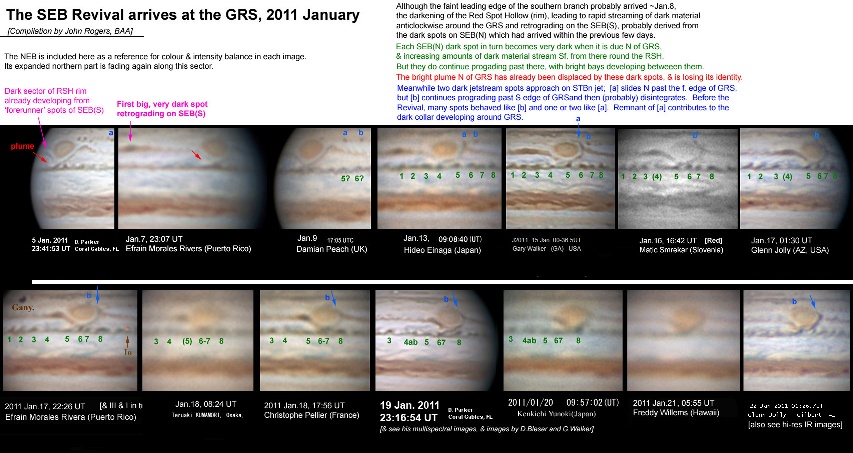
[20] The SEB revival interacts with the GRS (Feb 5th, 2011.)
Jupiter in 2010/11: BAA
Interim Report no. 20 (2011 Feb.5): The SEB Revival interacts with the
Great Red Spot
The appearance of the Great Red Spot (GRS) is changing dramatically, as
expected, since the southern and northern branches of the SEB Revival both
started interacting with it in January. Attached is a compilation of
images (2 files). Many thanks to all the observers who have sent images,
and to the ALPO and the ALPO-Japan for images which they have posted.
Both southern and northern branches started to darken the rim of the Red Spot
Hollow tenuously around Jan.5, and also darkened the SEB(S) f. the GRS. At
this time the incoming southern branch just consisted of slightly darkened
sawtooth projections ahead of the main dark spots; while the incoming northern
branch was a series of prograding dark spots which suddenly formed within the
darkened SEB(N) on Jan.5. Each SEB(N) dark spot in turn has become very
dark when due N of the GRS, and dark material streaming Sf. from these dark
spots was probably the main cause of the darkening of the RSH. But the SEB(N)
dark spots do continue prograding past the RSH, with bright bays developing
between them. The previous bright plume N of the GRS had already been
displaced by these spots, and lost its identity in mid-Jan.
Meanwhile, two dark spots approached on the STBn jetstream in mid-Jan.: one [a]
was deflected N alongside the f. edge of the GRS, but the other [b] continued
prograding past the S edge of the GRS then dissipated as a faint brown streak in
STB(N). (Before the Revival, many spots had behaved like [b], and one or two
like [a]: see our reports nos.8 & 12.) The remnant of [a] contributed
to the dark collar developing around the GRS.
In late Jan., this collar was further reinforced by a very dark grey streak
emitted from the dark spots N of the GRS, which extended anticlockwise around
the GRS. Its leading part emerged at the p. end of the GRS as a little
dark streak (Jan.29), which then expanded into a large, light brown loop (like
the LRS in 2008) - a bizarre sight in Don Parker's multispectral images on
Jan.31.
The first large, very dark spot on SEB(S) arrived at the GRS about Jan.17, and
seems to have contributed to a chaotic region of white and brown streaks due N
of the GRS, adjacent to the very dark grey spot from SEB(N), in late Jan.
The SEB(S) trailing behind it is generally dark with a cellular structure, but
without obvious vortices, and no distinct spots have been tracked from it into
the GRS circulation.
_________________________________
John H. Rogers, Ph.D. Jupiter Section Director,
British Astronomical Association
jhr11@cam.ac.uk
http://www.britastro.org/jupiter/
_________________________________